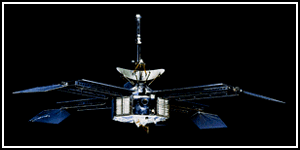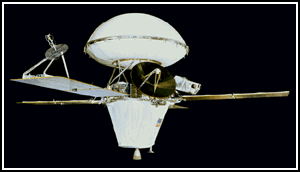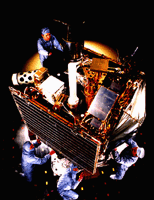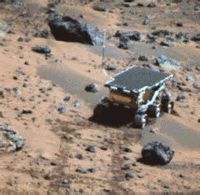Mariner 4

Mariner 4

The search for intelligent
life on Mars reached a fever pitch as we entered the Space Age. Because
of the evidence of intelligent life, Mars was an immediate target for space
programs globally. The first successful Mars mission was an American unmanned
flight called Mariner 4. This flight was crucial in finding the ďcanalsĒ
bogus and in discovering Mars cratered surface. These results came back
as a surprise to most astronomer
Mariner 6&7

. NASA launched Mariner 4 in
1964 and followed that with the Mariner 6 and 7 missions. Mariner 6 was
particularly successful in discovering that Marsí atmosphere was made of
carbon dioxide. After the Mariner flyby missions the image of Mars
changed from an Earth-like world to that of a barren moon-like planet.
Mars 2 & 3 Orbiter
The next Marsí mission to actually
reach Mars was the Mars 2 Orbital launched by the USSR in May of 1971.
Unfortunately for the USSR a dust storm covering most of Mars ruined any
good photographs the orbital might have taken. The Mars 2 Lander became
the first man made object to reach the surface of Mars when it crashed
into Mars on November 27, 1971.
Nine days after launching Mars 2 Orbiter the
USSR launched Mars 3, which had the first soft landing on Mars on December
2, 1971. Unfortunately 110 seconds after landing it stopped transmitting.
During that 110 seconds it did manage to send part of a picture to Earth.
That image combined with images taken by Mars 2 was made into a picture
of a dust storm that covered all of Mars that year. To get more complete
observations for themselves, NASA decided they had to put a spacecraft
into orbit around Mars.
Mariner 9


In 1976 NASA followed their
Mariner 9 mission with the favorable launchings of the Viking 1 and 2 Orbiter
and Lander missions. The Viking Orbiters were particularly successful in
showing that at one time water flowed on Marsís surface. This came
as quite a shock to most astronomers because liquid water simply cannot
exist on Mars today. Water is a liquid that can only exist within a certain
range of temperatures. What determines this temperature for water is atmospheric
pressure. Mars' atmospheric pressure is .007, and the average temperature
is only 218 k (-67 degrees Fahrenheit). With this combination of temperature
and pressure, water can exist as a vapor and as ice, but not liquid.
The Viking Landerís pictures showed that there were no obvious signs of
life on Mars. The landers however also were equipped with a miniature biological
laboratory in which to study microorganisms. NASA scientists figured that
anything that lives also must eat, breathe, and give off waste.
The landers both scooped up
soil samples to test if anything in the soil was actually alive. At first
when the tests were completed the Martian regolith showed tremendous signs
of organic change. Then scientists realized that it was not an organic
material that was changing but a chemical reaction because of the high
concentration of peroxides and superoxides. Besides tricking the scientists
into thinking they were organic, the peroxides and superoxides may have
also killed any organic material on Mars acting like a planet wide antiseptic.
Mars Global Surveyor

After the Viking missions space
exploration to Mars became an expensive hassle. NASA, forced by budget
cuts and failed super-expensive missions, did not make any new discoveries
on Mars until the Mars Global Surveyor or MGS was launched in 1996. The
MGS was a breakthrough for NASA Instead of making a massive spacecraft
with complicated and easily breaking expensive equipment NASA simplified
things and made MGS to be lighter, less costly but still have basic observing
instruments. The MGS may have been equipped with relatively basic instruments
but they were still able to produce good information.
The four best instruments
were a camera, a magnetometer, an altimeter, and a spectrometer. The camera
has stolen the spotlight so far, sending back amazing pictures like a cliff
wall that is composed of over eighty layers of rock strata. MGS has
also sent back important images of dry riverbed channels that may help
answer questions about water in Marsís history.
The magnetometer turned out
to be more useful than predicted. A mistake by NASA caused the MGS satellite
to have a larger elliptical orbit than planned. It caused the satellite
to fly close enough to Mars to get interesting readings in ancient Martian
lava. The magnetometerís readings showed that billions of years ago
Mars may have had a strong enough magnetic field to block out solar radiation
and give life on Mars a chance. This discovery was made possible by the
fact when lava is cooling the magnification in the lava stays the same
as when it was first formed. This would allow scientists to figure out
the history of the magnetic field on Mars.
The MGS altimeter is also
a nice piece of equipment. It measures elevations on surfaces of Mars within
one meter of their actual height. Scientists have been finding formations
that may help explain the history of Mars. In particular Marsí plains might
be revealed as an ancient sea floor.
The spectrometer can be a
special instrument because it is currently reading Marsí spectrum of infrared
heat. This allows for the possible detection of a material that would hint
towards a history of water on Mars. As a whole discoveries from the MGS
are still underway and within the next years as the MGS enters itís circular
mapping orbit it will begin to discover Mars more consistently and methodically.
Pathfinder
